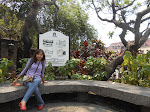(109, 209 and 409) in 2013,
The followings are the information of how to do your final assignment of designing English Language Assessment that will be
submitted on the day of final exam.
DESIGNING AND CONSTRUCTING THE ENGLISH LANGUAGE ASSESSMENT
1. Some considerations in constructing the language test items:
a. Refer to cognitive (mental skills) domain learning type from Bloom's taxonomy:
Cognitive domain includes the recall or recognition of specific facts, procedural
patterns, and concepts that serve in the development of intellectual abilities and skills.
b. Refer to sample item types from your handout by Vallete and Harris. Look at sample
item types of listening, speaking, reading and writing tests which best suit each of the
category of cognitive learning domain.
c. After considering to Bloom's Taxonomy and sample item types, you should also
consider the goals of the assessment items which can be based on curriculum 2013
(although I don't ask you to decide the grades for your group).
d. Refer also to ABCD method (Penn State, 2011) of designing the objective of the
assessment.
A (Audience) - Who? Who are your learners?
B (Behavior) - What? What do you expect them to be able to do? This should be
an overt, observable behavior.
C (Condition) - How? Under what circumstances or context will the learning occur?
What will the student be given or already be expected to know
to accomplish the learning?
D (Degree) - How much? How much will be accomplished, how well will the
behavior need to be performed, and to what level? Do you want
total mastery (100%), do you want them to respond correctly 80%
of the time, etc. A common (and totally non-scientific) setting is 80%
of the time.
Example of writing the assessment objective:
Given sentences written in the past or present and future (C),
the students (A) will be able to rewrite the sentence in future tense (B)
with no errors in tense or tense contradiction (D)
Now, look first at Bloom's taxonomy (Cognitive Domain):
Six major categories starting from the simplest behavior to the most complex:
1. Remembering
defines, describes, identifies, knows, labels, lists, matches, names, outlines, recalls,
recognizes, reproduces, selects, states.
2. Understanding
Comprehends, converts, defends, distinguishes, estimates, explains, extends, generalizes,
gives an example, infers, interprets, paraphrases, predicts, rewrites, summarizes,
translates.
3. Applying
Applies, changes, computes, constructs, demonstrates, discovers, manipulates, modifies,
operates, predicts, prepares, produces, relates, shows, solves, uses.
4. Analysing
Analyzes, breaks down, compares, contrasts, diagrams, deconstructs, differentiates,
discriminates, distinguishes, identifies, ilustrates, infers, outlines, relates, selects,
separates.
5. Evaluating
Appraises, compares, concludes, criticizes, critiques, defends, describes, discriminates,
evaluates, explains, interprets, justifies, relates, summarizes, supports.
6. Creating
Categorizes, combines, compiles, composes, creates, devises, designs, explains,
generates, modifies, organizes, plans, rearranges, reconstructs, relates, reorganizes,
revises, summarizes, tells, writes.
Example of designing and constructing the English language assessment using
Bloom's Taxonomy:
1. Remembering
A. Listening Assessment
Objective (ABCD method):
After finishing materials of greeting expression, the students are able to recognize
the correct simple expression of greeting by achieving 90 score from the rubric.
Sample item Type: Same vs Diffrence: Directed comparison
Instruction: You will hear one sentence. Indicate which sentence is exactly the
same as the sentence you listened.
Items:
1. The students listen: How are you?
Answer Sheet:
a. How are you?
b. How you?
c. How are your?
2. The students listen: I am very well, thank you.
Answer Sheet:
a. I am well, thank you.
b. I am very well, thank you.
c. I very well, thank you.
B. Speaking Assessment:
Objective:
Given the expression of greeting, the students are able to respond the expression
of greeting (to recall greeting expression) using all correct responses already taught.
Sample assessment type: Identifying picture
Instruction: Describe the picture given by your teacher.
Example: the students response: Hello, Good morning.
1. Teacher : "Are you happy now?"
Student's response : .....................................
C. Reading Assessment
Objective :
Given the examples of short functional text, the students are able to identify
and label the short functional text about signs on the street with 90 score based
on rubric made.
Sample item type: Single item picture- multiple choice format
Instruction: Select the correct sentence which best describes the picture.
1. a. Please, be quiet
b. Don't park here, please
c. Don't stop
D. WRITING ASSESSMENT
Objective:
Given the examples and explaining the short functional text, the students
are able to state the short functional texts of various purposes of 85% correct
sentences.
Sample Item type:
Picture test short question
Instruction: Answer the questions according to the pictures.
Example:
1. What picture is it?
Student's response: It is a card; it is a birthday card to a friend.
